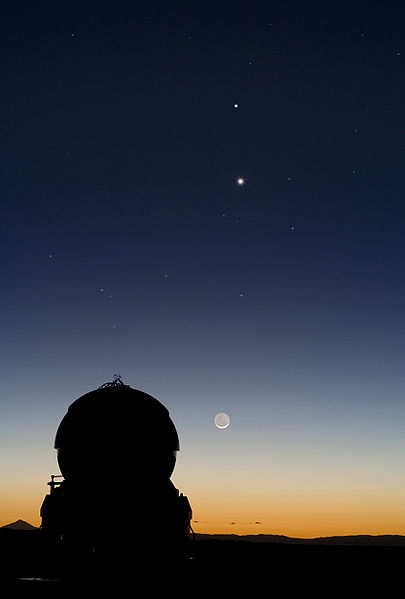Science News
Banquet for Planet-Watchers
March 13, 2012
by Bing Quock

If you’ve been looking westward on clear evenings shortly after sunset, you’ve no doubt noticed the two brightest planets visible in the heavens—brilliant, cloud-shrouded Venus and colossal Jupiter. They’ve been slowly drawing together over the past few months, and tonight, they’ll be separated by only 3 degrees, which is an angular distance equal to six full Moons.
Occurring near the time of Venus’ greatest angular separation from the Sun, this striking planetary close-encounter, is visible for several hours after sunset. Although apparently close together, the two planets are actually roughly a half-billion miles apart and simply located along the same line of sight.
There’s a slight variation in the dates given for this event, depending upon whether it’s referred to as a “conjunction” or as an “appulse.” The formal definition of an astronomical conjunction is when two objects have the same right ascension (the astronomer’s equivalent of longitude) on the celestial sphere, and this occurs on March 15. On the other hand, a conjunction may not necessarily be when the two are at their minimum apparent separation – an appulse – which occurs tonight. Either way, Jupiter and Venus won’t be seen this close together in the sky again until May 2013 – although that even closer encounter will be nearer to the Sun’s glow and not visible for as long after sunset.
The bad news? If you’re in the Bay Area, these rain clouds might get in your way. The good news? This event is only one highlight during a spectacular month of planet-watching.
During the next week, look low in the west about an hour after sunset for elusive Mercury, swimming in the twilight. Few people actually see Mercury, because it’s usually hidden in the Sun’s glare. Its window of visibility is in the process of closing, so look carefully.
A planet that doesn’t require such close timing is the red planet Mars, burning high in the southeast like an orange ember against the stars of Leo the Lion and bringing the number of planets visible at once to four.
Finally, at about 9:00 pm most evenings next week, look eastward for the ringed planet Saturn, rising side-by-side with the star Spica in Virgo the Maiden. Although by that time Mercury will be long-gone and Venus and Jupiter very low, this gives skywatchers a brief opportunity to see all five planets visible to the unaided eye within the short span of a few hours.
Bing Quock is the assistant director of the Morrison Planetarium.
Image: ESO/Y. Beletsky/Wikipedia